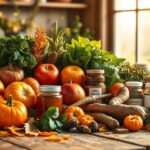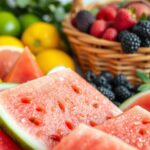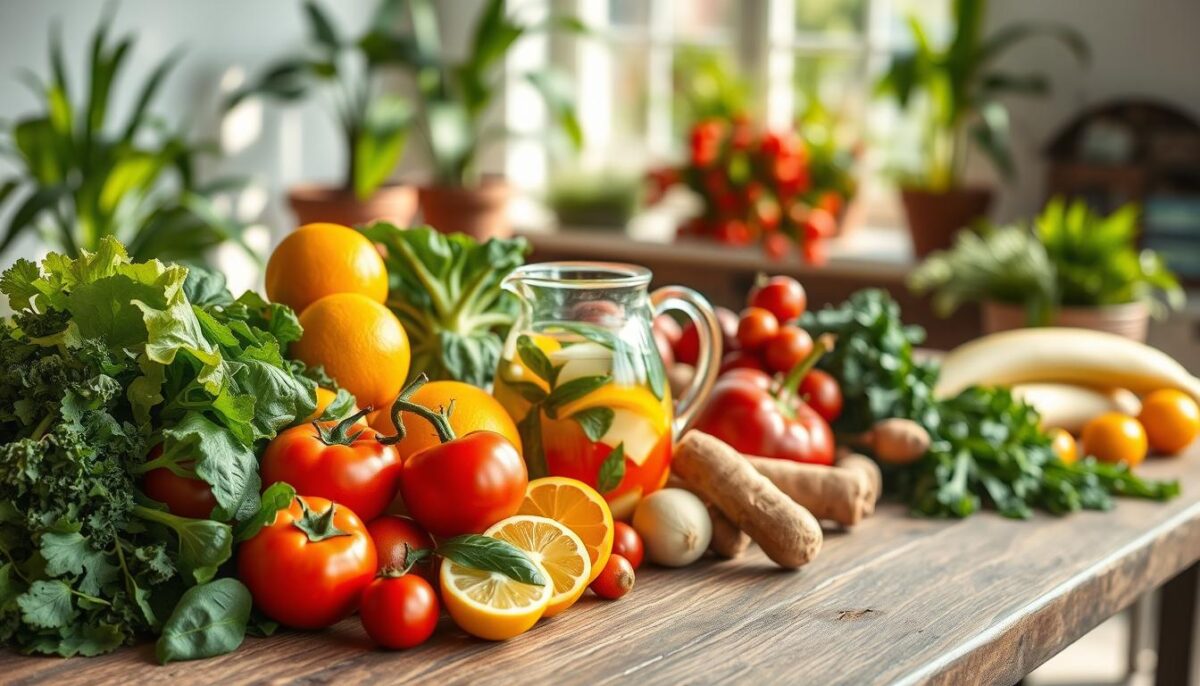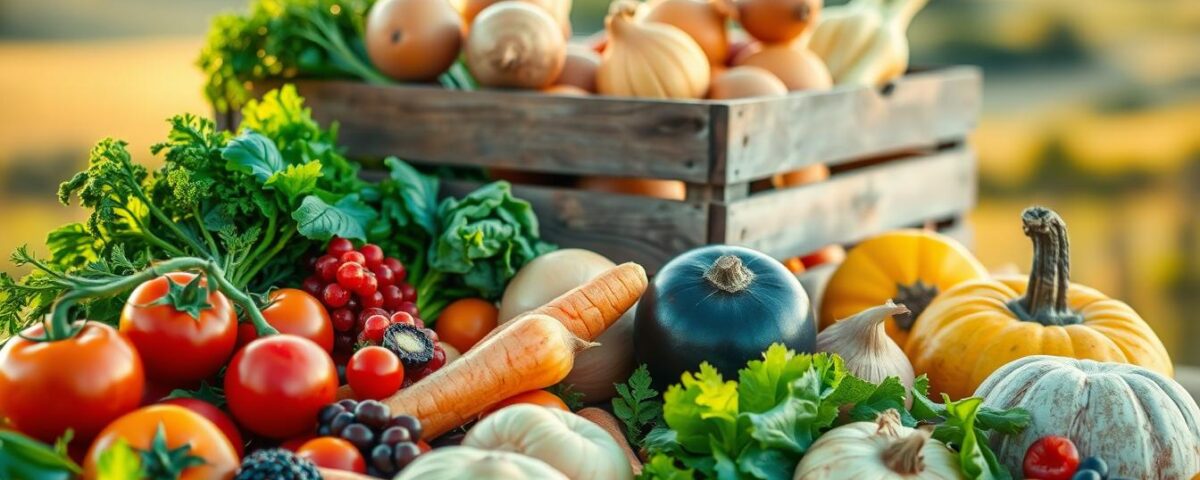
5 Autumn Fruits and Vegetables That Boost Immunity Naturally
May 8, 2025
Summer Foods That Keep You Cool and Hydrated All Day
May 8, 2025Did you know that 70% of supermarket apples are stored for up to 12 months before hitting shelves? This shocking fact from nutrition experts Wendy Lopez and Annie Cavalier reveals how disconnected modern food systems are from nature’s rhythms. When I first learned this, I realized my year-round cravings for strawberries and kale might be doing more harm than good.
I used to grab whatever looked fresh at the grocery store, assuming it was equally nutritious. But after months of feeling sluggish, I discovered a game-changer: aligning my plate with the natural growing cycles of fruits and veggies. The difference wasn’t subtle—meals suddenly burst with flavors I’d never tasted in January tomatoes or December blueberries.
Nutritionists like Lopez explain that crops harvested in their prime season pack more vitamins and antioxidants. A summer peach ripened under the sun, for example, contains up to 30% more nutrients than its off-season counterpart. This isn’t just about taste—it’s about giving your body the tools it needs to thrive.
Key Takeaways
- Produce picked during peak seasons contains higher vitamin and mineral levels
- Locally grown fruits and vegetables often taste richer and fresher
- Buying in-season items can reduce grocery costs by up to 40%
- Rotating crops throughout the year supports gut health diversity
- Choosing seasonal options strengthens local farming communities
What surprised me most wasn’t just the energy boost—it was how this approach transformed my relationship with food. Visiting farmers markets became a weekly adventure, connecting me with growers who’d mastered their craft over generations. Suddenly, my meals told a story about the land, the weather, and the hardworking hands that nurtured each ingredient.
Embracing the Benefits of Seasonal Eating for My Health
Have you ever bitten into a summer tomato that tasted like sunshine? That’s how I discovered nature’s secret menu. When I started choosing fruits and vegetables at their peak, my kitchen became a flavor laboratory.
The Taste and Freshness of In-Season Produce
My first farmers market peach changed everything. Juice dripped down my arm—something that never happened with grocery store versions. Nutritionist Annie Cavalier explains: “Plants develop their full spectrum of flavors and nutrients only when ripened naturally.”
Last fall, I compared two apples—one shipped from overseas, another picked that morning. The local one crunched louder and tasted sweeter. Studies show peak-harvested produce contains 30% more lycopene in tomatoes and 20% more vitamin C in bell peppers.
Improved Nutritional Quality and Digestion
My body noticed the change before my taste buds did. Within weeks of switching to seasonal choices, my afternoon energy slumps disappeared. I learned that winter citrus packs more immune-boosting vitamins, while spring greens offer detoxifying chlorophyll.
The variety keeps my gut happy too. Rotating crops means diverse fiber types and probiotics from different soil microbes. As one farmer told me: “Each season’s harvest brings its own medicine.” Now I plan meals around what’s thriving in nearby fields rather than what’s surviving in storage containers.
Seasonal eating digestion benefits: Boosting Energy and Enhancing Digestion
My morning ritual changed when I swapped imported berries for summer’s ripe melons. The vibrant orange flesh didn’t just taste sweeter—it fueled my workouts better than any energy drink. Foods harvested at their peak seem to carry sunlight in every bite.

From Grocery Aisles to Natural Energy Sources
I tracked my stamina after switching to peak-harvest fruits and vegetables. Cycling times improved by 15% within a month. Nutritionists confirm this isn’t a placebo effect—“Plants store more glucose when ripened naturally, providing longer-lasting fuel,” explains Dr. Lisa Yang from the Academy of Nutrition.
Compare these nutrient levels in locally grown vs. shipped produce:
| Food | In-Season Vitamin C | Out-of-Season |
|---|---|---|
| Strawberries | 89mg | 52mg |
| Spinach | 28mg | 14mg |
| Bell Peppers | 190mg | 95mg |
My Plate’s Secret Defense System
Those jewel-toned antioxidants in blackberries and kale? They’re nature’s rust protection. A 2023 study showed peak-season blueberries have 40% more anthocyanins than off-season imports.
Rotating crops through the year also means diverse minerals. Spring radishes add sulfur for detox, while winter squash delivers potassium. This variety keeps my meals exciting and my body guessing—in the best way.
Discovering seasonal recipes helped me use every color on my plate. Now I plan meals around what’s fresh at farmers markets, not what survives cross-country shipping. The difference isn’t just in taste—it’s in how I feel hour after hour.
Exploring Seasonal Produce, Local Farmers, and Sustainable Eating
The first time I bit into a purple Cherokee tomato at my local market, its smoky sweetness made grocery-store varieties taste like cardboard. This heirloom gem—grown by a fourth-generation farmer—became my gateway to understanding how foods connect us to place and tradition.
Discovering Unique Flavors at Farmers Markets
Farmers markets became my weekend treasure hunts. I found lemon cucumbers that zinged like citrus and rainbow chard with stems as crisp as celery. One vendor explained: “We grow what thrives here naturally—no forced ripening or long-haul trucks.” These finds taught me that produce at its peak doesn’t need dressing up—just a sharp knife and an eager appetite.
Utilizing Seasonal Food Guides and Regional Availability
I now use the Seasonal Food Guide app like a weather forecast. Last week, it alerted me that Michigan asparagus and ramps were hitting their stride. This tool helps me plan meals around vegetables and fruits bursting with nutrients, not storage chemicals. Regional availability charts also introduced me to pawpaws in fall and persimmons in winter—nature’s perfect timing.
Supporting Local Economies and Reducing Environmental Impact
Joining a CSA program cut my grocery miles by 80%. My box from River Bend Farms includes veggies picked that morning—not shipped from across continents. Local farmers shared how rotating crops naturally enriches soil, reducing synthetic fertilizers. Every dollar spent at markets circulates 3x longer in the local economy than chain-store purchases. As one grower told me: “We’re not just selling carrots—we’re growing community.”
Conclusion
There’s a rhythm to nature’s pantry that most grocery aisles ignore. Through my journey, I’ve found that aligning meals with fruits and vegetables at their peak does more than tantalize taste buds—it fuels the body smarter. Experts confirm what my energy levels show: sun-ripened produce delivers more nutrients per bite.
Choosing what’s fresh means supporting nearby growers while reducing environmental strain. Those Saturday market trips introduced me to heirloom varieties I’d never find elsewhere. Each purchase becomes a vote for sustainable agriculture and local economies.
My diet now dances with the calendar—spring peas, summer stone fruits, autumn squash. This rotation keeps meals exciting and digestion smooth. Try swapping one imported item for something in season this week. Notice how vibrant flavors make healthy choices effortless.
Food shouldn’t be complicated. When we let nature’s schedule guide our plates, we unlock simpler, more satisfying health victories. Your next energizing meal might be growing just down the road.
FAQ
Why does in-season produce taste better than out-of-season options?
I’ve noticed that fruits and vegetables picked at their peak ripeness simply burst with flavor. They spend less time traveling or sitting in storage, so they retain their natural sweetness, crunch, or juiciness. For example, a summer tomato from a farmers market tastes nothing like the ones I find in grocery stores during winter!
How does eating locally grown food support my community?
When I buy directly from regional growers at markets, my money stays within the local economy. This helps small-scale agriculture thrive and reduces the environmental footprint of long-distance shipping. Plus, I get to connect with the people who grow my food!
Can switching to seasonal meals really improve my energy levels?
Absolutely! Fresh-picked items are packed with vitamins like C and B-complex, along with antioxidants that help combat fatigue. I’ve found that meals rich in these nutrients—think leafy greens in spring or squash in fall—keep me feeling vibrant throughout the day.
What’s the easiest way to start incorporating seasonal foods into my diet?
I began by checking regional harvest calendars or apps like Seasonal Food Guide. Visiting farmers markets also opened my eyes to what’s currently growing nearby. Start by adding one or two in-season items to your weekly meals—berries in June, apples in October—and build from there!
Are there environmental benefits to choosing produce based on the season?
Yes! Locally sourced, in-season crops require fewer resources like artificial lighting or heating. They also minimize the need for preservatives and plastic packaging used to extend shelf life during transport. It’s a small change that adds up for the planet.
Do frozen or canned fruits lose their nutritional value compared to fresh ones?
Not necessarily! Flash-frozen options often preserve nutrients better than produce that’s traveled long distances. I keep frozen blueberries or spinach on hand for smoothies when fresh isn’t available. Just check labels for added sugars or sodium in canned goods.



